"The past history of Ulster is but a portion of Scottish history inserted into that of Ireland - a stone in the Irish mosaic of an entirely different colour from the pieces that surround it."
~ James Godkin
Thursday, September 30, 2010
Stolen from CK on Facebook
Wednesday, September 29, 2010
Ulster-Scots Bus Tour - Reminder
I know some of the folk coming on the bus tour on Saturday are readers here, so this is just a reminder that the coach will be leaving Ards Square at 8.45am, first stop is Newtownards Priory, which the Northern Ireland Environment Agency are opening up specially for us. We plan to be back at the Square for 1.00pm. If you can't make it please get in touch as there are people on a waiting list in the hope of cancellations. If the weather holds it'll be a great forenoon... if it rains, well, Hamilton and Montgomery didn't go back home in 1606 because of a wee skiff now did they? :-) Will post a report and photos next week.
Tuesday, September 28, 2010
Ballyfrenis United Free Church of Scotland, 1916
(Click the image to enlarge).
While Ulster-Scots continues to be the easy target of choice for the Northern Ireland media and chattering classes, ordinary folk take very little notice. Because for them, the connection with Scotland is deep and real, with generations of unspoken understanding of their Ulster-Scots heritage. The here-today-gone-tomorrow stoked "controversies" just pass by like a mizzle in the forenoon. A wheen o' weeks ago, I spent an evening with a family who live near Ballyfrenis (I'm going to keep them anonymous just for their own privacy), who shared with me an Aladdin's cave of old photographs and paper records going back into the mid-19th century. They are readers of this blog, which led to the invitation to go round and see them, and have given me permission to copy and post here some of the items. So shown left is a 1916 baptism certificate from Ballyfrenis United Free Church of Scotland, dated 20 November 1916. This is the church that my mother grew up in, and countless generations of her family before. I have blogged about the church previously.
The only way that authentic, rooted, Ulster-Scots work will happen is at the firesides and kitchen tables within the Ulster-Scots community itself. Our folk are a canny, wary lot, but once trust and a bond has been formed, I have always found most people to be very willing to share their own knowledge, stories and collections. Just a few days ago, a man who I'd met for the first time just the previous week sent me an envelope packed with stuff he'd gathered up over the years. On Saturday evening, I bumped into an older man who I've got to know over the past few years who updated me about his relatives in Lanarkshire and how they are waking up to their Covenanter history. Another man passed on a few wee Ulster-Scots expressions from the area of Co Down that he lived in for a while.
This richness only exists among the ordinary folk - the kind of people who FL Owsley called "The Plain Folk" - and who, if treated with the respect they deserve, are the salt of the earth. The sort of people that the controversy-manufacturers look down their noses at.
Friday, September 24, 2010
Red Mountain Music (I want to move to Alabama)
I have a cousin who lives there, so maybe a trip should be planned?! Thanks to Crawford for sending me this ages ago, I've just refound it.
Looking for the song "Kate of Carrowdore"
If anyone out there knows where I can find the words and musical notation for this old County Down song please get in touch.
Thursday, September 23, 2010
Ulster-Scots: A Quiz from Burma
If you'd been stuck on the border between Burma and India in 1944, your thoughts would probably have been of life at home. This was exactly the case for Ulsterman Eric Clark, who during his time in the army in Burma in WW2 wrote three wee volumes called "Ulster Quizbook" - as it says in the foreword they were "begun while convalescing in a hospital tent and completed in a beleagured jungle box on the Assam-Burma border". They occasionally surface in second hand bookshops. Each book had 45 ten question quizzes, so 450 questions in total. Lo and behold in Vol 1, Quiz 5, Question 5 is:
Who are the Ulster Scots?
The answer given at the back is "descendants of Scottish Presbyterians who emigrated to Ulster". A simplistic answer perhaps, but it does show that in the 1940s there was a popular awareness of Ulster Scots identity. The booklets are full of simple history, vocabulary and expressions. They were published by the Galleon Press of Ormiston Drive, Belfast, with the first volume published in December 1944. Clark wrote that Vol II had been completed "on the road to Mandalay" and that Vol III was completed "sailing amid the peace and beauty of our own Strangford Lough - a far cry from the Burma jungle".
Try these -
Vol 1, Quiz 13, Q7: Can you say what a "wheen o herns" is?
Vol 1, Quiz 33, Q2: Whereabouts in Co Down is The Big Stane?
Vol II, Quiz 17, Q5: The Grahams, a Scottish clan, were deported to Ulster and so gave this seaside village its name.
Vol III, Quiz 25, Q5: What other King landed at Carrick as well as King Billy?
Monday, September 20, 2010
Bangor's Royal Charter, 18th March 1613
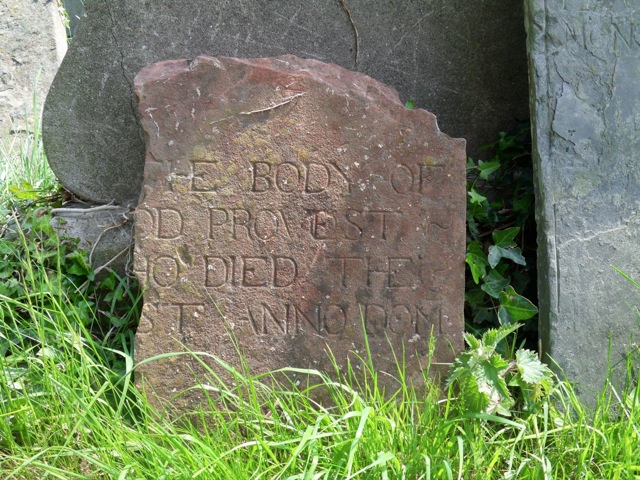
Pic above - fragment of the gravestone of one of Bangor's Provosts or "Provest" (see how the stonemason was in two minds about whether it should be spelled with an "o" or an "e" ! ) Photographed at Bangor Abbey, June 2010.
In my previous post, about John Luke, I included his mural of Belfast's Royal Charter. 2013 sees the 400th anniversary of King James VI & I granting Royal Charters to 14 towns across Northern Ireland and a further 26 within the Republic of Ireland. Locally, the three which are most relevant to me are the Charters for Killyleagh (10 March 1613), Newtownards (25 March 1613) and Bangor (18 March 1613). The full texts of the Bangor and Killyleagh charters are in The Hamilton Manuscripts - thanks to Ian Wilson for reminding me of that!
To summarise the Bangor charter, King James VI & I ("in the 10th year of our reign in England, France and Ireland, and in the 46th of Scotland") granted "the inhabitants of the village or town of Bangor" the following:
• Bangor would be an "entire and free Borough"
• A "body corporate and politic" would be set up with one Provost, twelve free burgesses and a Commonalty. John Hamilton was the first Provost of Bangor (He was Sir James Hamilton's brother). These positions were to be reappointed every year - for the Provost his election was to be on the Feast of St Michael the Archangel / Michaelmas (Sept 29); for the Burgesses their election was to be on the Feast of the Nativity of Saint John the Baptist (June 24).
• the right to elect two MPs to Parliament - "two understanding and fit men"
• the "Commonalty" was to be made up of "all the inhabitants of the said village, and all and such other men as the Provost and free Burgesses shall admit".
• safeguards were also built in to get rid of any of these appointments, for example that in instances of "mal-administration and ill-behaviour in that behalf be removed".
• a weekly civil Court to be held on a Saturday
• convene public assemblies to "statute, ordain and establish acts for the good rule and wholesome government of the said Borough", and appoint two "Sergeants at Mace and other inferior officers or ministers necessary for better government"
• establish a Merchant Guild with a seal and coat of arms
• hold a "free market" every Thursday, and two other annual fairs on 11 November "to be held yearly for ever" and 1 May "to be held yearly for ever". In a year where these dates fell on a Saturday or Sunday the fairs were to be held the following Monday. The Provost held the post of "Clerk of the Market".
A document dated 1833/1834 also contained in The Hamilton Manuscripts (entitled 'Corporation Commissioners Report on Bangor') shows that the town and Borough of Bangor was, over 200 years later, running more or less on the basis set up by the 1613 Charter.
Surely these Charters, and the stories of the towns, should be marked in some meaningful way?
Saturday, September 18, 2010
The Paintings of John Luke (1906 - 1975)
(Left: John Luke's mural at Belfast City Hall, showing Belfast's Royal Charter of 1613, painted in 1950. Click the image to enlarge).
Even though I went to the Art College in Belfast (UU at Belfast, 1990 - 1994) I have limited knowledge of our local artistic heritage. I opted to take a commercial route with my own career - solving other people's communication needs and helping them sell products, rather than the self-expression route of the fine artist. So I ended up as a graphic designer with a love of old tourism posters. (By the way, if you hire a graphic designer and they present concepts to you by saying "well, what I wanted to do with this was..." you have my permission to shoot them. Their job is to answer your brief, not indulge themselves or enhance their portfolio. Too many these days flounce around like they're presenters on Changing Rooms).
The Foundation and BAHons courses I took had no art history modules, but I made good money painting Iron Maiden album covers on schoolbags during my teenage years and can draw Gill Sans by hand - both of which I found far more useful than learning about dead Italian painters. However, one Ulster artist whose work I have always greatly admired is John Luke (1906-1975). The first painting of his that I saw was "The Road to the West" (painted in 1944) which was then (and might still be) in the UTV art collection.
John Luke has an interesting background, in that his parents were from Ahoghill (some say Randalstown) and moved to booming industrial Belfast where John was born in Lewis Street. Apparently his early works included painting King Billy on gable walls. Later he painted the magnificent mural in Belfast City Hall which shows the Royal Charter if 1613 being read (see pic above). So I Googled him the other day and found to my horror that one of his public murals, about 30 feet by 20 feet, languishes in the possession of a Belfast demolition firm (see story here) - a firm who were involved in a publicly funded £20m construction project and who then claimed the Luke mural under a salvage clause in the contract. (The mural was probably paid for out of the public purse in the first place, by the old Belfast Corporation. You might also think that a firm who have presumably done very well from the public contracts over the years might demonstrate some goodwill and return the mural to the people of Northern Ireland?).
Anecdotally, I am told that some of Luke's family were Brethren evangelists, but John became a vegan Buddhist and died in poverty from a malnutrition-related illness.
Rory Fitzpatrick speaks of Luke's work - "...how many people looking at the work of the Belfast artist John Luke would recognize in it a theme going back to the beginnings of the Scots-Irish?... it is always Sunday in Luke's work, families walking their dogs through the green, drumlin country in the warm afternoon, or evening after work as a father comes home to a white Ulster farmhouse set in formal idyllic landscape. Luke himself called it 'the eternal, now' but it is in essence that curiously innocent Scots-Irish vision, the land of peace and plenty, often expounded in the past from Presbyterian pulpits and expressed in Biblical language...". (from God's Frontiersmen, p 274).
If any of the Luke family read this, I would love to hear from you.
NB - As far as I know, all of these paintings are copyright of Luke's estate, these digital images been sourced from various websites.
> Ulster History Circle biography and plaque
> Wikipedia entry for John Luke
The Road to the West, 1944
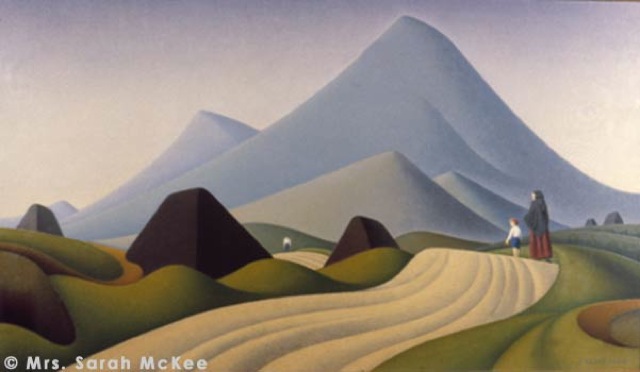
The Old Callan Bridge, Armagh, 1945
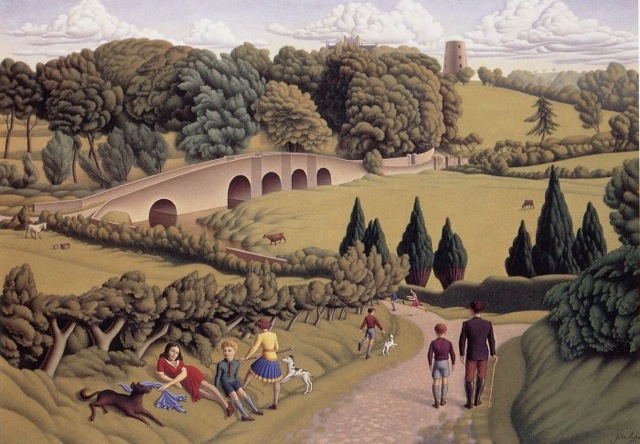
The Lock at Edenderry, 1944
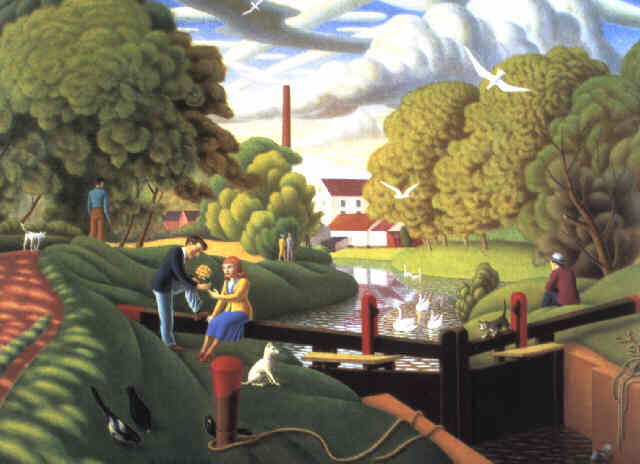
Ballygally Castle, 1939
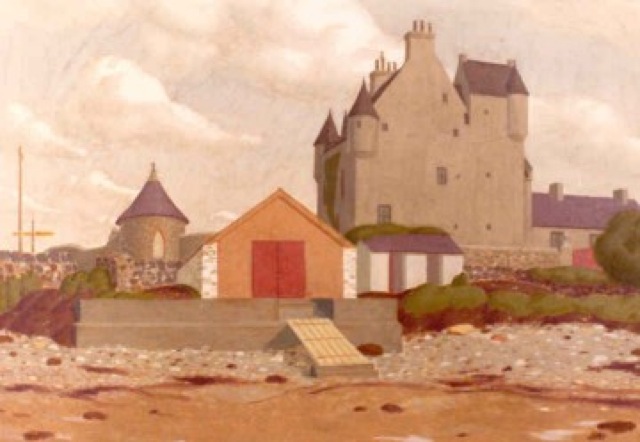
Landscape with Figures, 1948
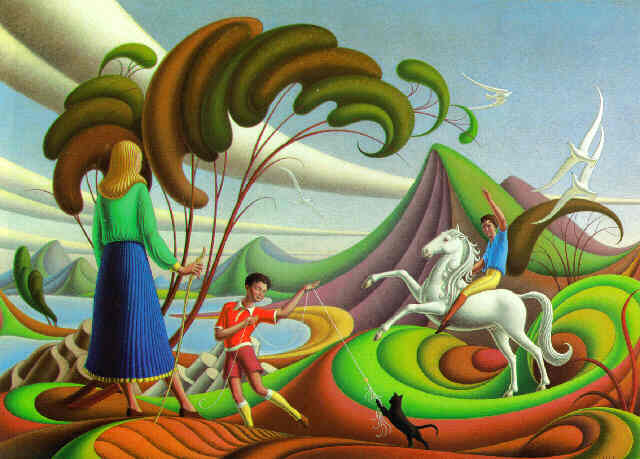
The Myth of the Ulster-Scots
"...The greatest of the myths is that of the non-existence of the Ulster Scots as a separate people with a distinguished history and rich traditions. Lip service is paid by British and Irish politicians to the idea of a Protestant cultural identity, usually by a polite mention of the Twelfth of July as a folk festival; no attempt is made to probe beneath the cultural surface..."
Rory Fitzpatrick wrote that, 21 years ago in his book God's Frontiersmen - the Scots-Irish Epic (Weidenfield & Nicholson, London 1989) p 274. It's almost a prophetic observation and it still applies today. The Twelfth is a fine day out, but as I've written before, there's far far more to our heritage than just one day in July.
...........
God's Frontiersmen is out of print and very hard to find, so click here to see if any are currently available on Abebooks.com
Friday, September 17, 2010
Ulster-Scots History at the British Library
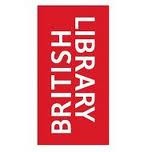
I was pleased yesterday to receive an email from The British Library to say that they have selected three major projects I led during my time at the Ulster-Scots Agency to be included in their Web Archiving Programme. The websites for Hamilton & Montgomery (2006), UlsterVirginia (2007) and The Covenanters in Ulster (2008) have been chosen. The purpose of the Web Archiving Programme is to "... select and archive sites to represent aspects of UK documentary heritage and as a result, they will remain available to researchers in the future. The British Library works closely with leading UK institutions to collect and permanently preserve the UK web... We aim to develop preservation mechanisms to keep your publication permanently accessible as hardware and software change over time."
So these stories will now be permanently stored under the digital protection of one of the world's great learning institutions. With thanks to those who worked voluntarily with me on these three major projects, to Dr John McCavitt for his advice on the BL archiving programme, and to the British Library for deeming the projects to be important enough to preserve them for future generations.
Thursday, September 16, 2010
"So Mrs Morrow, how are your bowels?"
"Bouls doctor? We dinnae hae ony bouls, jist a wheen o plates".
(told to me tonight by Billy Morrow about his granny's report of a visit to her GP, about 60 years ago!)
Monday, September 13, 2010
Newtownards Ulster-Scots Concert Evening - Friday 15th October @ 7.45pm
A wee bit of a plug - As well as our usual church events across Northern Ireland throughout the Autumn, Graeme and I are delighted to be taking part in ‘An Evening of Ulster Scots Music and Crack’ which is part of Newtownards Ulster-Scots Festival Week organised by Loughries Historical Society. The venue is the Londonderry Room in the Old Town Hall Newtownards.
• Hosted by Newtownards man David Anderson MVO, MBE.
• Also performing will be Lord Londonderry’s Own CLB Band
• Wilbert Magill (local poet, writer, accordion player and radio star! Wilbert and I played together - accordion and mandolin - at the open air meeting in Carrowdore a few Saturday evenings in August)
• Newtownards Orange Male Voice Choir
• There will also be a talk on Asha Kiran School in India by Billy Curry. (a retiring offering will be collected in aid of the school).
Entry is £6.00 per person, pay at the door (no tickets). There will be light refreshments and, if you're lucky, you might even get to see the old jail cell (see photo below) where many a troublesome Ulster-Scot has been held over the years!
NB - numbers are limited, so please get in touch with me, or with Mark Anderson at Balmoral Perspective, if you want to go. Rumour has it that the refreshments might include proota breid which Mark will be making fresh that afternoon from spuds grown in his back yard, so he'll need to know how many drills to hoke up! I can vouch for his spuds - very good with some scallions and country butter. And his beetroot is very good too, but he hasn't disclosed his secret pickling recipe yet.
Wednesday, September 08, 2010
Off to Ards Historical Society shortly...
... I'm dusting down my Powerpoint talk on Hamilton & Montgomery (the second most important story in ever told). See you at 8pm in the Town Hall! Will post a report later on of how it went.
UPDATE - went really well, I spoke for my allotted hour (had to skip a few bits to keep it down to the hour!). Between 50 and 60 people there, lots of questions at the end and lots of very positive feedback all round. I met folk tonight who are friends of my parents but who I'd never met before, local teachers, parents of schoolfriends of mine, a woman from Edinburgh who now lives near Carrowdore, a man from Ballintoy who now lives near Newtownards, even a few folk who admitted to having heard me try to sing!. They've asked me back again - the ultimate accolade.
The critics of Ulster-Scots have no idea of how deeply our stories resonate within our local communities. Or maybe they do...? Media, politicians and assorted "experts" can spout whatever they like within their ivory towers. I know where I'll be - among my ain folk helping to preserve, recover and share our extraordinary heritage to whatever extent I'm able.
Tuesday, September 07, 2010
From Ballyhalbert to Galloway - a morning view from last week
The only sound was the put-put-put of the wee inboard engine, around 7.30am. I've lived all my life on the coast here, and the view to Scotland has been a regular feature of every one of my 38 years. Some of my first steps were taken on this very beach (when my parents lived along the front of Ballyhalbert, before they bought the farm from the Johnstons, a farm my father had laboured on since he was a wee boy. His father and uncles had laboured those fields as well, as did their parents, as far back as family tradition goes.). All three of my own children have learned to walk on the same stretch of sand. I think most folk have places which are special to them - for me, the coastline from McCammon Rocks to Mooney's Brae is almost part of my DNA. Click the photo to enlarge.
Posted by Mark Thompson at Tuesday, September 07, 2010 2 comments
Labels: Ards Peninsula, Close Coastlines
Sunday, September 05, 2010
The life and writings of James M'Henry of Larne (1785-1845)
"Work! An' was it for that, after a', that I left the snug toonlan' o' Maughrygowan, an' cam' owre the ocean, whan I thocht I wad become a gentleman on my very landin! Work! why what waur could I hae done at hame, than to hae laboured for my daily bread! But I was nae quite at that need either. Eh! Sirs - Nelly, puir lass! is as little likely to become a 'lady in Pennsylvania' as the sang we used to sing says, that she was in her ain country!".
............
These are the first words spoken by Gilbert Frazier, an Ulster-Scots emigrant who left the countryside between Coleraine and Londonderry in April 1723, and sailed with his wife Nelly to Philadelphia. Gilbert was the key character in the novel The Wilderness; or, Braddock's TImes - a Tale of the West, which was published in New York in 1823.
It was written by James M'Henry who was born in Larne on 20 December 1785, and may well have been inspired by his own life. He studied medicine at Glasgow University, while there he published a poem about the 1798 Rebellion - which he would have witnessed as a teenage boy - entitled Patrick: A Poetical Tale of 1798 (published by McKenzie, Glasgow 1810). M'Henry returned to Co Antrim and became a doctor in Larne in 1811 - he then moved to Belfast in 1814 and emigrated to Pennsylvania in 1817. He lived there for 25 years during which time he became one of the most celebrated writers and novelists of his generation. He was Editor of the American Monthly Magazine, first published in 1824 (first volume is available on GoogleBooks, featuring some of his own work, and runs to a colossal 574 pages). In 1842 he returned to Ulster and became American Consul in Londonderry, a post he held until his death on 21 July 1845.
The characters of M'Henry's works were predominantly Ulster-Scots - in the preface of Hearts of Steel (1825) he wrote that "the majority of actors in both works belonged to the population of Ulster; the lower and middle classes of whom speak a dialect very similar to that spoken by the Scotch Lowlanders, from whom they are mostly descended". When Lady Morgan / Sydney Owenson's 1806 novel The Wild Irish Girl characterised Ulster as "... a Scottish colony; and in fact, Scotch dialect, Scotch manners, Scotch modes, and the Scotch character almost universally prevail..." he may have been pleased by her recognition of the cultural distinctiveness of the Province - but when the description went on to attack the alleged "chill", "calculating industry" and "luxury" of Ulster he was far from happy.
He is said to have used the preface of Hearts of Steel to respond directly to Owenson, but also more broadly to writers of her ilk, who were elevating the idea of romantic Gaelic Ireland and lambasting Scottish Presbyterian Ulster . Have a read at the bottom of page vi and the top of page vii - doubtless Owenson was one of the "tribe of romance writers who have... spread this false notion of the Irish character which has gone abroad through the world. That these writers in general knew extremely little of the people they undertook to describe is evident..." - which of course, in the addition to my recent blog post entitled "He Shoots He Scores", is still an issue today.
Chapter Two of The Hearts of Steel has been described as a "tour de force" - the deathbed scene of an old Antrim farmer called John Rainey, in which he admits his part in a crime of passion that saw him commit a murder, which the dying victim mistakenly said had been carried out by Rainey's best friend. Rainey was then tasked with giving his friend fifty lashes at Carrickfergus Castle, during which the innocent man died - making Rainey a double murderer. The language is marvellous.*
M'Henry has also been described as a "personal friend and ardent admirer" of another son of east Antrim, President Andrew Jackson, and in 1829 published a volume entitled "Jackson's Wreath or National Souvenir" (available here on GoogleBooks). James M'Henry was a hugely significant figure of his generation, regarded as the first "Irish-American" novelist and deserves to be better known in Ulster today. Like so much of Ulster-Scots heritage M'Henry has been forgotten and ignored. Nobody is sure where he was buried - his brief entry in the Oxford Dictionary of National Biography says he died at Larne. A blue plaque either near Larne (if his birthplace or even grave could be traced) or the site of the former Consuls' premises in Londonderry should be considered.
(If M'Henry were alive today, he might even have been featured in an episode of "Jackie's the Boy".)
LINKS:
- Memoir of James M'Henry's life
- The Wilderness on Archive.org
- biography of James M'Henry (p43 - 55)
-The Wilderness as a searchable text base from Stanford University, California
* this chapter was featured in Frank Ferguson's Anthology of Ulster-Scots Writing (Four Courts Press 2008). This blog post was inspired by a series of old emails from 2005 that I recently stumbled over, from John Erskine, Philip Robinson and Richard MacMaster. With thanks to all of them for their interest and for sharing their thoughts and information.
Saturday, September 04, 2010
"...one more triumph for the crass stupidity rapidly replacing culture in this country..."
No, it's not about certain aspects of present-day Ulster-Scots activity (although you may feel that it could be), but is instead an excerpt from the football fanzine / magazine When Saturday Comes. Football isn't rocket science, and frankly it's not that important (even though I enjoy it immensely) however WSC has recently published two pieces ripping apart how even something as trivial as football coverage has been dumbed down. This article is about former Soccer AM presenter Tim Lovejoy, and this one is about the dire James Corden's World Cup programmes that dominated ITV's coverage of this years tournament.
Here are a few excerpts from the Corden article: "...a thickening culture of bullish arrogance, absolute pride in not thinking. This idea that it's all a laugh. It's eating away at everything now, and it's only getting worse..."Lovely stuff!" barked Corden, banging his cards on the desk. Somewhere in Britain, another library closed...
...no idea of his own limitations, never sensing when people are sick of him... underneath the insecure bluster, he may even be a nice guy... what he has to realise now, as he weeps over England's exit, is that he's part of the problem. Sure, it's only a laugh – but this overbearing oafishness bolsters the culture which has England stinking out one tournament after another, bullishly arrogant, proud of not thinking. Corden would probably scoff at the thought, but I guess you have a different perspective when you're making a career of it..."
The language in both pieces is rough in places, so be warned before you choose to click through. Apply the themes as you see fit.
"The Ulster Scot" - Home Rule era postcard
While hoking through some old books yesterday I found a clipping from the Belfast Telegraph, from 19th January 1998 to be precise, of an article entitled "Light Shed on Ulster and the Thistle Connection" which was published to promote the book Varieties of Scottishness: Exploring the Ulster Scottish Connection (published by the Institute of Irish Studies, Queen's University Belfast, 1997). The article was illustrated by an old postcard bearing the title "The Ulster Scot" in bold lettering - it has an illustration of a highland warrior with kilt, sporran, shield and sword, and the following verse:
This land oor heritage by richt
Priest ridden saints may grudge us
Three hunner years we hae been here
An deil th' fit they'll budge us
Not very PC, but I think a significant insight into popular feeling around 1912 and the "Home Rule is Rome Rule" fears of the time. I also vaguely remember seeing another postcard from the same era, I think recording the Larne gunrunning of 1914, which also bore an Ulster-Scots verse or poem. Maybe some readers know it and can send it to me to post here?
Friday, September 03, 2010
He shoots, he scores! (with new addition)
Over at Aiblins.com, Mr Ulster Scot looks like he's hit the target with this one.... PS - Also, check this out. Sadly this commentator perpetuates the nonsense about "manufactured identity". It's not the first time that academics have dismissed something just because they'd never heard of it before. I have left a comment there (which has to be approved before it will appear). Perhaps some of you might feel inclined to do likewise? Even academics still have a lot to learn.
Thursday, September 02, 2010
Wednesday, September 01, 2010
Testing testing
Oops - doing a few tests with Blogger at the moment as I'm weighing up an upgrade, so bear with me if things go a bit weird round here for a day or two.






